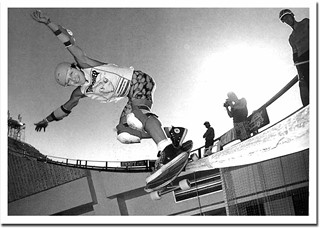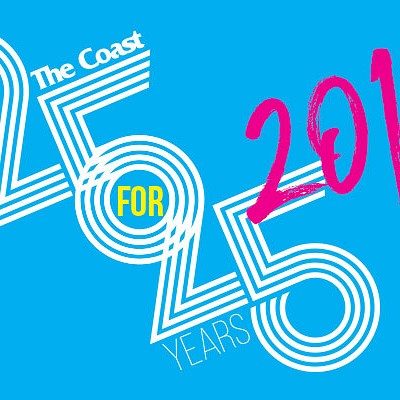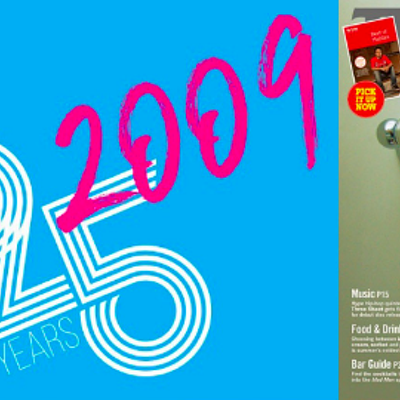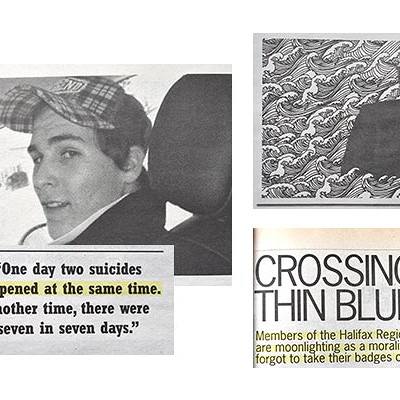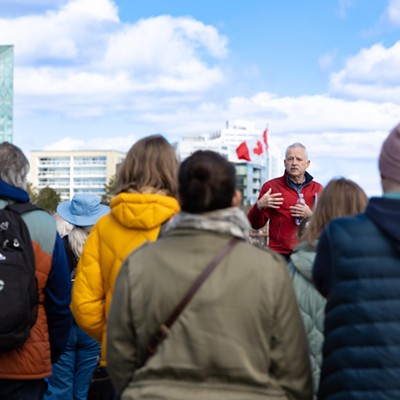We shopped. We voted. We fell off of skateboards and shared dirty little secrets. Two thousand six was an eventful year in Halifax, one that would be impossible to condense onto one page of blurbs. But here goes.
Khyburned
The year began with a cruel blow to Halifax’s artistic community: The Khyber Club, a long-standing bar/gallery/music venue on Barrington Street, was unexpectedly shut down by the city in early February with little warning or explanation. Shortly after the announcement, the chalkboard hanging outside the Khyber tersely summed up the situation: “The HRM has decided to close The Khyber Club. Saturday, February 4, is it. No, we don’t know why.”
The Khyber building is owned by the city—prior to February, it had been operating under lease to the Khyber Arts Society. The weeks following the announcement brought protests, a petition campaign to save the Khyber, and a makeshift goodbye show on the 19th. There was also much speculation about the city’s true rationale for closing the club, speculation that continued throughout 2006. The Khyber, meanwhile, still opens once in a while for private shows and special occasions, but it’s far from the permanent venue it was back in 2005.
Peter Kelly falls down
It was a good year for Peter Kelly damage control.
Take, for example, the time the mayor tried to skateboard. Kelly made the attempt during a photo opportunity on the Halifax Common on March 1 while symbolically accepting a cash donation towards the new Common skatepark—“tried” being the operative word, because the mayor fell. Hard. He wrecked, if you will.
As if the fall weren’t painful enough on its own, it got worse, because Kelly wasn’t wearing any protective gear—no helmet, no kneepads, no wristguards. Nothing. Just a light jacket and a sense of adventure. The mayor’s poor safety example was captured on film and splashed all over the city.
The next day began the mayoral safety campaign, complete with yet another Peter Kelly photo-op, this time with promotion and protection minister Barry Barnet, who dropped by city hall with brand new safety helmets for downtown councillor Dawn Sloane (who also boarded without proper equipment) and the mayor.
Ditto the mayor’s child-maiming candy-throwing incident during this year’s Parade of Lights, when a local boy was needed four stitches after being hit in the face by a projectile Sour AppleGator, allegedly thrown from the mayor’s float. The mayor was quick to crack down on irresponsible public candy throwing. He also made arrangements to try and meet with the boy and his mother, making it also a very good year for Peter Kelly photo-ops.
Spring Garden and Queen gets short-term screwed
Like the look of that parking lot that currently sits on the corner of Spring Garden and Queen? You’d better—it may stay that way for a long time. Ever since the old Halifax Infirmary site was demolished and the block at the corner of Spring Garden and Queen became vacant, the space has either looked like a construction site or a parking lot. Inspiring? Not really. Actually, pretty appalling. At public consultations last spring, residents argued about the future of the site and advised how the site might be made useful in the short-term—turn it into a park, they said, or a skating rink, or a market. Unfortunately, the province already had plans to make the site a parking lot in an interim basis. In this case, interim could mean years. So, while we wait for some of the large-scale developments proposed for the Spring Garden and Queen land—like a new public library, for instance—we get ground parking, and lots of it, on one of our most prominent downtown corners.
R-Mac presides
Nova Scotia premier Rodney MacDonald faced his first election in June, despite already serving as premier prior to the election after taking over for the retiring John Hamm. The young Cape Breton-born former fiddler/gym teacher didn’t manage to make any major inroads into Halifax, something that the provincial Conservatives were hoping their young fresh-faced premier might be able to do. Voters in the city still tended to cast their ballot for the NDP—the NDP’rs took 13 seats of the 18 seats up for grabs in the HRM.
Violence in the streets
Violence wasn’t new to Halifax this year, but it did get a lot of attention. Halifax’s dirty little secret became less and less of a secret as 2006 went on. Swarmings continued to be a problem as residents on the peninsula complained that downtown violence was getting out of hand. The fatal stabbing of US sailor Damon Crooks in early November on Argyle Street led to the Mayor’s downtown violence summit, and discussion turned to hiring more beat cops and installing surveillance cameras on some “high-crime” areas, such as pizza corner. For better or worse, it is the Crooks incident that will likely stick in Halifax’s collective conscience.
Condifax
US secretary of state Condoleezza Rice stopped by Halifax on September 11 to thank Canadians—and specifically, Maritimers—for their aid in the aftermath of the 9/11 attacks in New York. Peter Mackay dutifully showed Condi around the province, flirting all the way. During Condi’s visit, groups of up to 100 people gathered in downtown Halifax to protest American foreign policy and Canada’s continuing military commitment in Afghanistan.
The Stones start debate, me up
Love it or hate it, the Concert on the Common will go down in history as one of the biggest and most polarizing events of 2006. It chewed up a corner of the Common, yes, and it did leave the public ground fenced off for the final few months of the year, but we can’t deny, there was a giddy thrill knowing that Kanye West and Mick Jagger were strutting around Halifax, eating at local restaurants, and making us feel—if only for a day or two—like big shots. Will it be a gateway to more large-scale concerts? More shows on the Common? More investment in arts and culture (ha!)? We don’t know. Was it handled properly? Again, debatable. But it certainly was memorable.
Can’t stop the shop
In early October, after weeks of legal challenges from Sobeys and Atlantic Superstore, the provincial government threw the door wide open for Sunday Shopping, effectively turning over a 2004 plebiscite on the matter. Mere hours after the grocery giants won their legal challenge to remain open on Sundays, premier Rodney MacDonald said that the government would not appeal the decision, and would allow all businesses to open “regardless of what they sell.” We haven’t stopped shopping since.
Microcredit conference
Sometime in the mid-1970s, Muhammad Yunus loaned a relatively small amount of his own money—the equivalent of roughly 30 dollars—to a group of poor families who made bamboo furniture and other small items in his home country of Bangladesh. It was a small gesture that freed the recipients from a predatory lending system and gave them an opportunity to put aside and save some of their own profits.
A simple act, based on a relatively simple principle: large banks tend to disregard the very poor because they lack collateral—but that shouldn’t disqualify the poor from the benefits and opportunity that a loan—even a very small loan—can provide. That, in a nutshell, is the foundation of Microcredit.
The Nobel Peace Prize-winning Yunus was in Halifax for the Global Microcredit Summit, which ran from November 12 to 15. Yunus’ Grameen Bank has now lent billons of dollars to millions of borrowers, the vast majority of beneficiaries being women. Microcredit organizers took the opportunity in Halifax to announce their latest long-term goals: to ensure that 175 million of the world’s poorest families have access to credit by 2015, and to help 100 million of the world’s poorest families move above the $1/day threshold by 2015. Admirable goals, and wonderful that they would be discussed and launched here.
The school board self-destructs
They tried everything. They switched chairpersons. They changed seating plans. They enlisted the help of a mediator. But ultimately, the Halifax Regional School Board was judged too dysfunctional to do its job. In December, education minister Karen Casey made it official by dissolving the 13-person board and appointing a single representative to assume the board’s responsibilities.
In January, the African-Nova Scotia board rep Doug Sparks got the party started by refusing to take his seat in a revised seating plan, saying that he had a Charter right to sit wherever he wanted. Things only went downhill from there. There were scandals about members missing meetings, conflicts of interest and always, always the fighting.
Name the biggest story in 2006. Email: [email protected]

